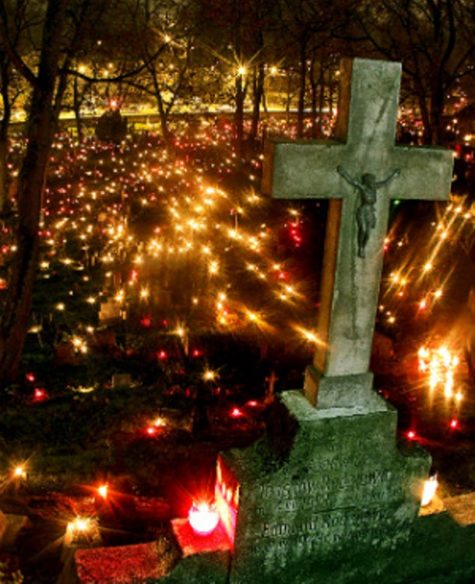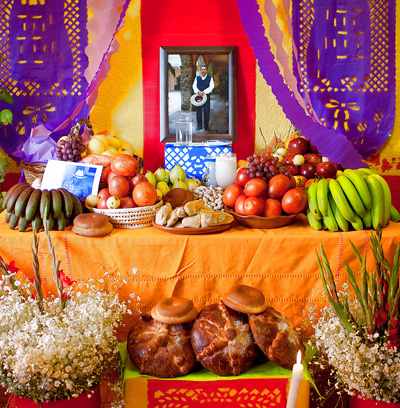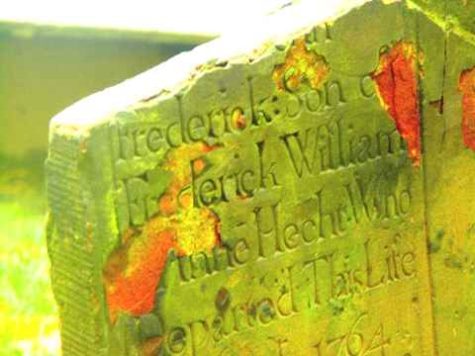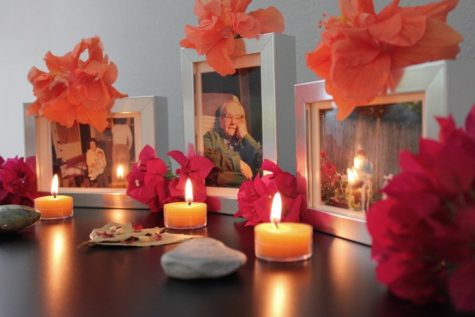Ancestors
There is a Mexican saying that we die three deaths: the first when our bodies die, the second when our bodies are lowered into the earth out of sight, and the third when our loved ones forget us.
Some believe that the origins of All Souls’ Day in European folklore and folk belief are related to customs of ancestor veneration practiced worldwide. It is practically universal folk belief that the souls of the dead (or those in Purgatory) are allowed to return to earth on All Souls Day. In Austria, they are said to wander the forests, praying for release. In Poland, they are said to visit their parish churches at midnight, where a light can be seen because of their presence. Afterward, they visit their families, and to make them welcome, a door or window is left open. In many places, a place is set for the dead at supper, or food is otherwise left out for them.
In any case, our beloved dead should be remembered, commemorated, and prayed for.
During our visits to their graves, we spruce up their resting sites, sprinkling them with holy water, leaving votive candles, and adorning them flowers (especially chrysanthemums and marigolds) to symbolize the Eden-like paradise that man was created to enjoy, and may, if saved, enjoy after death and any needed purgation.
Today is a good day to not only remember the dead spiritually, but to tell your children about their ancestors. Bring out those old photo albums and family trees! Write down your family’s stories for your children and grandchildren! Impress upon them the importance of their ancestors!
Traditional foods:
Around the world:
The formal commemoration of the saints and martyrs (All Saints’ Day) existed in the early Christian church since its legalization, and alongside that developed a day for commemoration of all the dead (All Souls’ Day). The modern date of All Souls’ Day was first popularized in the early eleventh century after Abbot Odilo established it as a day for the monks of Cluny and associated monasteries to pray for the souls in purgatory.
Many of these European traditions reflect the dogma of purgatory. For example, ringing bells for the dead was believed to comfort them in their cleansing there, while the sharing of soul cakes with the poor helped to buy the dead a bit of respite from the suffering of purgatory. In the same way, lighting candles was meant to kindle a light for the dead souls languishing in the darkness. Out of this grew the traditions of “going souling” and the baking of special types of bread or cakes.
In Tirol, cakes are left for them on the table and the room kept warm for their comfort. In Brittany, people flock to the cemeteries at nightfall to kneel, bareheaded, at the graves of their loved ones, and to anoint the hollow of the tombstone with holy water or to pour libations of milk on it. At bedtime, the supper is left on the table for the souls.
In Bolivia, many people believe that the dead eat the food that is left out for them. In Brazil people attend a Mass or visit the cemetery taking flowers to decorate their relatives’ grave, but no food is involved.
In Malta many people make pilgrimages to graveyards, not just to visit the graves of their dead relatives, but to experience the special day in all its significance. Visits are not restricted to this day alone. During the month of November, Malta’s cemeteries are frequented by families of the departed. Mass is also said throughout the month, with certain Catholic parishes organizing special events at cemetery chapels.
In Linz, funereal musical pieces known as aequales were played from tower tops on All Soul’s Day and the evening before.
In Mexico “Dia de Los Muertos” (Day of the Dead) is celebrated very joyfully — and colorfully. A special altar, called an ofrenda, is made just for these days of the dead (1 and 2 November). It has at least three tiers, and is covered with pictures of Saints, pictures of and personal items belonging to dead loved ones, skulls, pictures of cavorting skeletons (calaveras), marigolds, water, salt, bread, and a candle for each of their dead (plus one extra so no one is left out).
A special bread is baked just for this day, Pan de Muerto, which is sometimes baked with a toy skeleton inside. The one who finds the skeleton will have “good luck.” This bread is eaten during picnics at the graves along with tamales, cookies, and chocolate. They also make brightly-colored skulls out of sugar to place on the family altars and give to children.
Collected from various sources
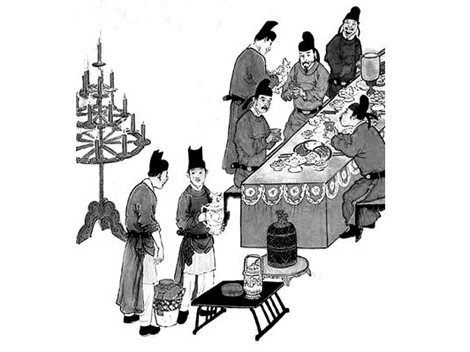 The Cold Food Festival or Hanshi Festival is a traditional Chinese holiday celebrated for three consecutive days starting the day before the Qingming Festival in the Chinese Calendar, which falls on the 105th day after dongzhi (April 5 by the Gregorian calendar, except in leap years). It is celebrated in China as well as the nearby nations of Korea and Vietnam. At this time of year, the sky becomes clearer and buds sprout in the field. Farmers sow various seeds and supply water to their rice paddies.
The Cold Food Festival or Hanshi Festival is a traditional Chinese holiday celebrated for three consecutive days starting the day before the Qingming Festival in the Chinese Calendar, which falls on the 105th day after dongzhi (April 5 by the Gregorian calendar, except in leap years). It is celebrated in China as well as the nearby nations of Korea and Vietnam. At this time of year, the sky becomes clearer and buds sprout in the field. Farmers sow various seeds and supply water to their rice paddies.
The Cold Food Festival started from the ancient tradition of setting fire by rubbing wood pieces together and the tradition of lighting new fires. Due to the change of seasons and the change in the type of wood available, the ancient practice was to change the type of fire-starter-wood used from season to season. Fire is lighted anew upon the start of each season. Before the new fire is officially started no one is allowed to light a fire. This was an important event during that time.
The traditionally practiced activities during the Cold Food Festival includes the visitation of ancestral tombs, cock-fighting, playing on swings, beating out blankets (to freshen them), tug-of-war, etc. The practice of visiting ancestral tombs is especially ancient.
In China ancestral worship used to be practiced during the time of the Cold Food Festival. It was later moved to coincide with the Qingming Festival. However in Korea, where the festival is called Hansik , the tradition of ancestral worship during the Cold Food Festival still remains.
In the modern version of Hansik, people welcome the warm weather thawing the frozen lands. On this day, rites to worship ancestors are observed early in the morning, and the family visits their ancestors’ tombs to tidy up.
Falling on the 105th day after the winter solstice (April 5 by the Gregorian calendar, except in leap years). At this time of year, the sky becomes clearer and buds sprout in the field. Farmers sow various seeds and supply water to their rice paddies. The custom of eating cold food on this day is believed to originate from a Chinese legend (see Tomb Sweeping Day), but recently this custom has disappeared.
Since this day coincides with Arbor Day, public cemeteries are crowded with visitors planting trees around the tombs of their ancestors.
In Vietnam, where it is called Tết Hàn Thực, the Cold Food Festival is celebrated by Vietnamese people in the northern part of the country on the third day of the third lunar month, but only marginally. People cook glutinous rice balls (see recipe and more info) called bánh trôi on that day but the holiday’s origins are largely forgotten, and the fire taboo is also largely ignored.
Source: Wikipedia
Qingming Festival (also known as Pure Brightness Festival or Tomb-sweeping Day), falls on either April 4th or 5th of the Gregorian calendar. The Chinese respect for filial piety and careful attention to funeral rites is visibly manifested in the custom of ancestor worship.
Since ancient times, a day has been designated for sweeping the tomb and honoring one’s ancestors. Though different in each family, these rites are usually performed on the first few days prior to or following Ching Ming, one of the traditional solar divisions falling in early April, when the frost retreats and spring returns bringing renewal to all living things.
When visiting the tomb, people usually bring the dead person’s favourite food and wine, and paper resembling money . This is in the hope that the deceased are not lacking food and money. After burning the paper money, tidying up the tomb, and putting willow branches around the gates and doors of the tomb to ward off evil spirits, people will eat the food and fruit before returning to their homes.
The folklore behind the story is as follows:
It is said that the Qingming Festival was originally held to commemorate a loyal man living in the Spring and Autumn Period (770 – 476 BC), named Jie Zitui. Jie cut a piece of meat from his own leg in order to save his hungry lord who was forced to go into exile when the crown was in jeopardy. The lord came back to his position nineteen years later, and forgot Jie Zitui but later felt ashamed and decided to reward him. However, Jie had blocked himself up in a mountain with his mother. In order to find Jie, the lord ordered that the mountain should be set on fire. Later Jie was found dead with his mother. In order to commemorate Jie, the lord ordered that the day Jie died was Hanshi (Cold Food) Festival – the day that only cold food could be eaten.
The second year, when the lord went to the mountain to sacrifice to Jie, he found willows revived, so he gave instructions that the day after Hanshi Festival was to be Qingming Festival. Later, the two festivals were combined as one.
Traditional Customs
Qingming Festival is a time of many different activities, among which the main ones are tomb sweeping, taking a spring outing, and flying kites. Some other lost customs like wearing willow branches on the head and riding on swings have added infinite joy in past days. The festival is a combination of sadness and happiness.
Cleaning the tomb and paying respect to the dead person with offerings are the two important parts of remembering the past relatives. Weeds around the tomb are cleared away and fresh soil is added to show care of the dead.
Today, with cremation taking over from burying, the custom has been extremely simplified in cities. Only flowers are presented to the dead relatives and revolutionary martyrs. No matter how respect is shown, good prayers for the deceased are expressed.
All in all, the Qingming Festival is an occasion of unique characteristics, integrating sorrowful tears to the dead with the continuous laughter from the spring outing.
From: Travel China Guide
January 31 is Disfest or Disablot which is a day of sacrifice honoring the Disir. The Disir are all the female relatives from the eons of time that have passed over and over see as well as protect their living family members.
In some homes every candle and light is lit in the house to honor them. A sacrifice of the very best food and drink in the house is given to the Land Wights as well. It is a day of remembrance and honoring the females that passed over and to thank them for their loving protection.
Source: Pagan Calendar
The ancient Romans celebrated the Lemuria on May 9, 11, and 13. During these times they honored the wandering ancestral and family spirits. Many modern people still make the trip to the cemetery during the Memorial Day weekend for the purpose of putting flowers on graves, a way of acknowledging and remembering deceased family members.
However, it is not necessary to go to cemeteries to honor your ancestors. In your long lineage, most of your ancestors will not have been buried near you, and some will have been cremated and their ashes scattered or their physical bodies lost. This day of remembrance is not to honor a decayed physical body, but to honor the bloodlines that led to your existence.
Set up a spot within your home as a temporary ancestor altar; choose a setting that will not be disturbed for at least a week. On this altar place what pictures you have of deceased family members. If you have no pictures, print out their names on a nice piece of paper. Arrange a small vase of fresh flowers near the pictures. Burn lavender or rose incense daily near this area.
Sometime during each day of this week, go to your remembrance altar and talk with your ancestors. Don’t forget to call upon the ones so far back in your lineage that you never met them. burn a white candle there for at least an hour each day.
Perhaps you have a few immediately deceased family members with whom you didn’t get along. Most people do. If you find their spirit energies causing problems (and some will do this), simply remove their pictures until they can behave themselves. This may sound silly, but it works on most spirits. They want to be remembered and acknowledged not put out of mind and sight.
Often those family members with whom there was the most friction will be of most help because they may want to make up for bad karma. Occasionally, a very few will be incorrigible and will have to be denied admittance to your home.
Each day, ask your ancestors for advice and help. If you meditate near this shrine, you may well find yourself visiting with loved ones. And remember to think about and call upon them throughout the rest of the year, especially at important occasions. You can light candles, or set extra places at the table for them during seasonal festivities such as birthdays, thanksgiving and Christmas.
From: Moon Magick
